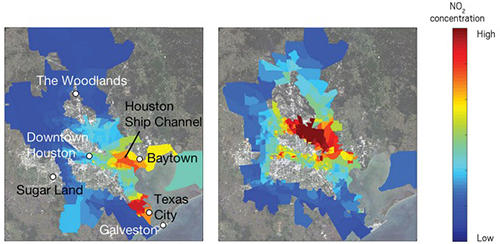A .gov website belongs to an official government organization in the United States.
A lock () or https:// means you've safely connected to the .gov website. Share sensitive information only on official, secure websites.
6 August 2020

A study published in the American Chemical Society (ACS) journal Environmental Science & Technology provides new, direct evidence that disparities in air pollution exposure exist between neighborhoods of differing demographics and socio-economic status in Houston, Texas. The paper is led by Angelique Demetillio and Sally Pusede of the University of Virginia and co-authored by CSL's Brian McDonald along with colleagues from NASA.
Using a combination of satellite remote sensing observations of NO2 from the TROPOspheric Monitoring Instrument (TROPOMI) and aircraft measurements collected during the NASA sponsored Deriving Information on Surface conditions from Column and Vertically Resolved Observations Relevant to Air Quality (DISCOVER-AQ) mission, researchers found that nitrogen dioxide (NO2) pollutant levels are typically ~37% higher in low-income, non-white neighborhoods compared to neighborhoods with predominantly high-income, white residents. On especially bad air quality days with stagnant conditions, this disparity can be as high as 80%. The researchers point to the close proximity of low-income neighborhoods to the industrial portions of Houston near the Houston Ship Channel where the petrochemical industry is clustered. Studies such as this one are important for informing air quality regulations and policy, which may have differing outcomes across a city like Houston, and are critical for evidence-based evaluation of controversial issues regarding environmental justice.
Demetillo, M.A.G., A. Navarro, K.K. Knowles, K.P. Fields, J.A. Geddes, C.R. Nowlan, S.J. Janz, L.M. Judd, J. Al-Saadi, K. Sun, B.C. McDonald, G.S. Diskin, and S.E. Pusede, Observing nitrogen dioxide air pollution inequality using high-spatial-resolution remote sensing measurements in Houston, Texas, Environmental Science & Technology, doi:10.1021/acs.est.0c01864, 2020.
Houston, Texas is a major U.S. urban and industrial area where poor air quality is unevenly distributed, and a disproportionate share is located in low-income, non-white, and Hispanic neighborhoods. We have traditionally lacked city-wide observations to fully describe these spatial heterogeneities in Houston and in cities globally, especially for reactive gases like nitrogen dioxide (NO2). Here, we analyze novel high-spatial-resolution (250 m x 500 m) NO2 vertical columns measured by the NASA GCAS airborne spectrometer as part of the September 2013 NASA DISCOVER-AQ mission and discuss differences in population-weighted NO2 at the census-tract level. Based on the average of 35 repeated flight circuits, we find 37 ± 6% higher NO2 for non-whites and Hispanics living in low-income tracts (LIN) compared to whites living in high income tracts (HIW) and report NO2 disparities separately by race ethnicity (11−32%) and poverty status (15−28%). We observe substantial time-of-day and day-to-day variability in LIN-HIW NO2 differences (and in other metrics) driven by the greater prevalence of NOx (≡NO + NO2) emission sources in low-income, non-white, and Hispanic neighborhoods. We evaluate measurements from the recently launched satellite sensor TROPOMI (3.5 km x 7 km at nadir), averaged to 0.01° x 0.01° using physics-based oversampling, and demonstrate that TROPOMI resolves similar relative, but not absolute, tract-level differences compared to GCAS. We utilize the high-resolution FIVE and NEI NOx inventories, plus one year of TROPOMI weekday−weekend variability, to attribute tract-level NO2 disparities to industrial sources and heavy-duty diesel trucking. We show that GCAS and TROPOMI spatial patterns correspond to the surface patterns measured using aircraft profiling and surface monitors. We discuss opportunities for satellite remote sensing to inform decision making in cities generally.